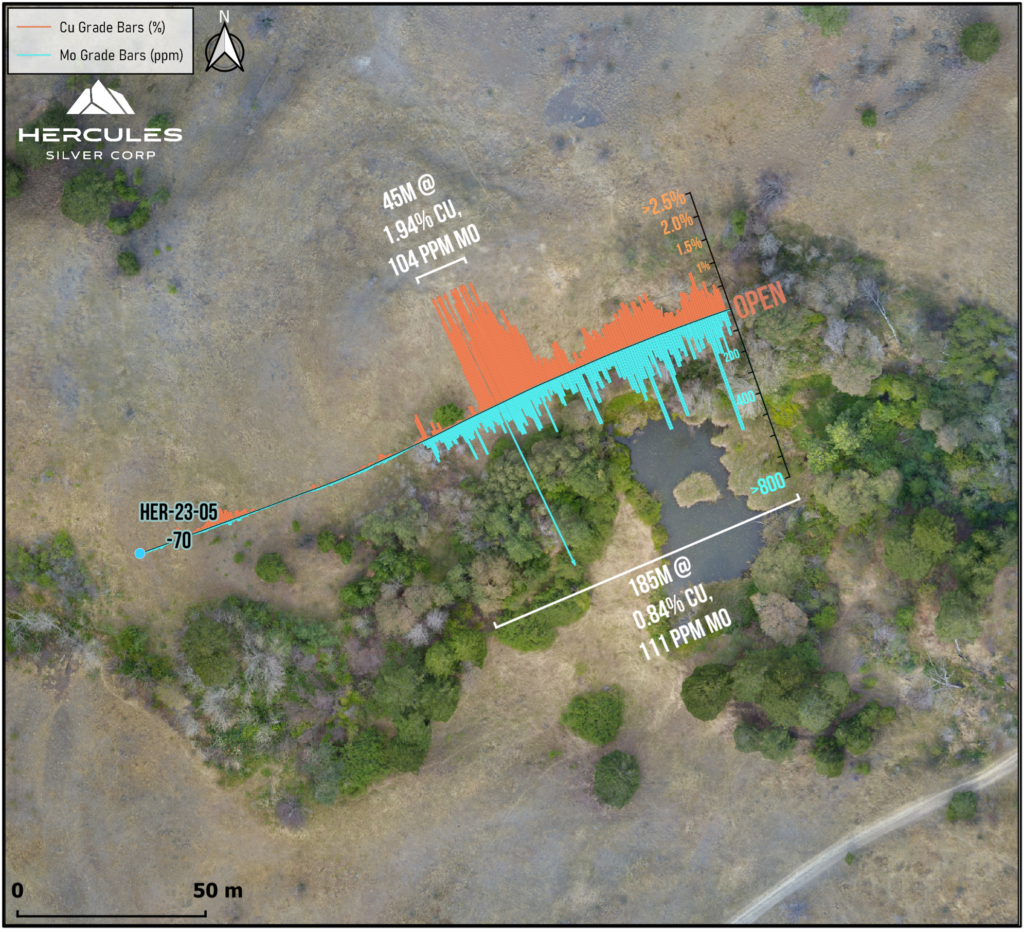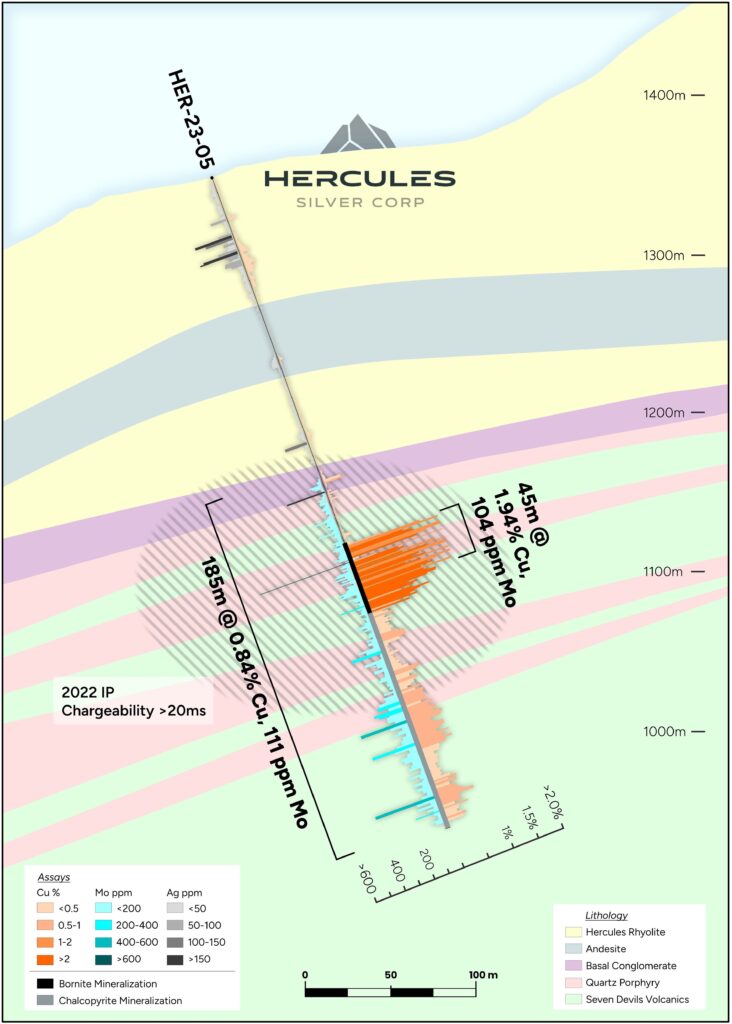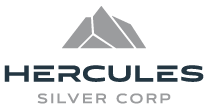Hercules Silver Corp. (“Hercules Silver” or the “Company”) (TSX-V: BIG) (OTCQB: BADEF) (FWB: 8Q7) is very pleased to confirm a major new copper porphyry discovery at its Hercules Property located in western Idaho (“Hercules” or the “Property”).
HER-23-05, the first hole to test a large-scale (>1.8km) blind chargeability anomaly, intersected 185.29m of 0.84% Cu and 111 ppm Mo from 246m to 431.2m, including 45.33m of 1.94% Cu. The hole ended prematurely due to drilling challenges encountered at a post-mineral dyke, however observations in subsequent holes indicate that the mineralization likely extends significantly below HER-23-05 at 435 meters.
The newly discovered porphyry system is situated below rhyolite-hosted silver mineralization defined by over 300 historical drill holes. The system is therefore completely blind and open in all directions from HER-23-05. A follow-up 3D IP survey is currently underway to expand the chargeability anomaly in all directions and help track the system with further drilling.
Additional step-out holes drilled at various orientations to the southeast of HER-23-05, where chargeability data is currently available, have intersected similar alteration, veining and copper mineralization over variable lengths. Many directions remain to be tested, and the potassic center, which often carries the highest grades within porphyry systems, remains to be found. Assay results will be released for step-out holes as they are received. Core photographs for the intercept reported in this release have been posted to the Company’s website at the following link:
- Blind copper porphyry discovered in first deep drill hole grading 0.84% Cu, 111 ppm Mo, 2.6 g/t Ag over 185m, including 45m of 1.94% Cu.
- Hole ended prematurely in mineralization due to drilling challenges. Step-out drilling indicates system extends considerably deeper.
- Mineralization open in all directions from discovery hole.
- Additional 3D IP geophysics underway to establish limits of the system and guide further drilling.
- Assays pending for additional step-out drill holes.
Chris Paul, CEO and Director of the Company, noted: “We are incredibly pleased with the grades returned from our first blind drill hole into this new discovery. It has significantly exceeded our expectations, considering phyllic alteration typically occurs outside of the grade shell in porphyry copper systems. The strength of the alteration, veining and mineralization in HER-23-05 and subsequent step-out holes however is demonstrating the presence of a very large system which remains open in all directions.
HER-23-05 also represents the first significant porphyry copper system discovered in the state of Idaho, which breaks the discovery gap between BC and Nevada, presenting an entirely new district for porphyry exploration in a tier 1 jurisdiction.
The Triassic-Jurassic island arc geology of the Hercules Copper Belt is reminiscent of British Columbia’s famous Golden Triangle, where some of the world’s largest porphyry copper systems have been discovered. The Hercules Copper Belt, however, is accessible year-round, with excellent infrastructure and a supportive, pro mining state government.”
Table 1: HER-23-05 Reported Intercept
| Hole ID | From (m) | To (m) | Interval (m) | Cu (%) | Mo (ppm) | Ag (g/t) |
| HER-23-05 | 246 | 431.29 | 185.29 | 0.84 | 111 | 2.6 |
| including | 246 | 291.33 | 45.33 | 1.94 | 104 | 8.2 |
Table 2: HER-23-05 Location
| Hole ID | Easting | Northing | Depth (m) | Azimuth | Dip | Hole type |
| HER-23-05 | 511231 | 4956639 | 435.32 | 69.78 | -70.06 | Core |

Figure 1: Plan view of discovery hole HER-23-05, collared in the Frogpond Zone showing grade bars for copper (orange) and molybdenum (blue).

Figure 2: HER-23-05 cross-section with interpreted geology, grade bars for copper (orange), molybdenum (blue), and silver (grey).

Figure 3: Copper in soil and rock samples, IP chargeability, 2023 deep drill holes completed.
Blind Porphyry Copper System
Field work completed by the Company in 2022 previously demonstrated the potential for a porphyry copper feeder system on the east side of the Property, within the Seven Devils Group volcanics. However, due to logistical constraints, a shallow IP geophysical survey was only run over silver mineralization on the west side of the Property in 2022. Regardless, the deeper parts of the survey showed a strong chargeability anomaly below the silver mineralization on the west side of the Property.
HER-23-05 was the first drill hole to test this new chargeability target, and unexpectedly encountered the Seven Devils Group volcanics, but accompanied by stronger porphyry-style alteration, veining, and mineralization than was observed at surface on the east side of the Property. The mineralization in HER-23-05 extends well below the limit of the 2022 survey data. Subsequent holes, for which assays remain pending, have now intersected similar alteration, veining and mineralization below the silver mineralization in other places. The 2022 IP survey was designed with tight node spacing, to focus on shallow silver mineralization; however, a 2023 survey is now underway, employing a much larger node spacing to more effectively target this newly discovered porphyry system at depth.
On surface, a shallow west-dipping thrust fault (shown in red on Figure 3), separates copper-gold-molybdenum bearing Seven Devils volcanics (the “Lower Plate”) to the east from the silver-lead-zinc-manganese bearing Hercules Rhyolite (the “Upper Plate”), to the west. East of this thrust, several known copper-gold targets, including the Big Cut Skarn, Lightning Breccia, and Metheny Zones are exposed at surface, and remain to be tested. West of the thrust, 2023 drilling has now demonstrated that the copper porphyry system dips shallowly below the silver mineralization at moderate depths of just 100m-300m.
HER-23-05 Geological Description
HER-23-05 intersected silver-lead-zinc-manganese mineralization at surface and was continued to depth to test the blind chargeability anomaly. At approximately 197 meters (645 feet) depth, a strongly hematized (oxidized) “red conglomerate” unit was intersected, which is interpreted to mark the base of the Jurassic volcanics. The conglomerate also marks the top of the porphyry system, below which strongly silicified andesite and quartz porphyry intrusions contain abundant quartz-hematite veining. Hematite is a common oxidation/weathering product, suggesting the conglomerate may represent an ancient (paleo) erosional surface, on which the silver system was subsequently thrust over. Molybdenum mineralization (soluble in high pH) begins immediately below the red conglomerate; however, copper appears to have been leached by acidic (low pH) solutions within the hematized/weathered zone (Figure 2).
Strong bornite-chalcopyrite mineralization then begins at 246 meters (807 feet), immediately below the leached/hematized zone, extending over a 45-meter drilled length of enrichment. Studies are currently underway to better understand the mechanism of enrichment/remobilization, however it appears to be significant, as the same pattern has now been observed in four deep drill holes.
Below the enriched zone, mineralization transitions to a typical pyrite-chalcopyrite (phyllic) assemblage, which extends to the bottom of the hole, where the post-mineral dyke was encountered, and at which point drilling challenges caused the hole to end prematurely. The same phase of post-mineral dyke has now been intersected in two other deep drill holes, where it only shows several meters of drilled length. It is likely the post-mineral dyke at the end of HER-23-05 has a similar thickness and was meters away from being back in strong mineralization.
Alteration observed in HER-23-05 and other deep holes consists of quartz-sericite-pyrite (phyllic alteration) with abundant porphyry-style A, B, and D-type veining. Phyllic alteration manifests as an outer shell of highly chargeable pyrite (+/- chalcopyrite) mineralization, that often surrounds an inner shell of chalcopyrite (+/- bornite) mineralization with lesser pyrite. The inner shell is often accompanied by high temperature potassic alteration, characterized by biotite and k-feldspar. Figure 3 illustrates the many directions and broad search area that remain to be tested for the potentially higher-grade potassic core as well as further extensions of the system. HER-23-05 and this news release represent just the first blind test of the porphyry system at depth.
2023 3D IP Survey
Surveying is currently underway, to expand the 2022 survey, which measures approximately 2,200m by 650m, to a significantly larger area of approximately 4.2 km by 3.6 km. It is anticipated that the 2023 survey will better define and likely extend the 2022 chargeability anomaly, indicate the trend of the system, and provide up to 3x deeper data.
Sample Analysis and QAQC
All drill core samples were prepped and analyzed at MSA Labs in Langley, British Columbia, an ISO 17025 and ISO 9001 certified laboratory. Samples were dried and crushed to 2mm, from which a 250g sub-sample split was then pulverized to 85% passing a 75 micron sieve. Following preparation, assays were determined by the IMS-230 method. A 0.25g aliquot of the prepared pulp was digested in a 4-acid solution consisting of hydrochloric, nitric, perchloric and hydrofluoric acids. 4-acid is a near total digest and only the most highly resistant minerals are not dissolved. The resulting solution was analyzed via ICP-MS and ICP-ES for 48 elements and was corrected for inter-element spectral interferences. Lower detection limits for this procedure are 0.01 ppm for silver, 0.5 ppm for lead, 2 ppm for zinc, and 0.2 ppm for copper. Mercury is not reported due to volatilization in reaction with hydrofluoric acid and gold is not reported due to the small, 0.25g aliquot size being insufficient to overcome the nugget effect.
Gold was analyzed by FAS-111, a 30-gram fire assay fusion with AAS finish. No significant results were reported.
Samples with initial results beyond the upper detection limit of the IMS-230 method were analyzed by procedures ICF-6Ag, ICF-6Cu, ICF-6Pb and ICF-6Zn. The thresholds are 100 ppm for silver, and >1% for copper, lead and zinc.
MSA Labs employs internal quality control standards, duplicates and blank samples at set frequencies.
Blind certified reference materials (CRMs) and blank samples were systematically inserted by the Company into the sample stream and analyzed as part of the Company’s quality assurance/quality control protocol.
Qualified Person
The scientific and technical information in this news release has been reviewed and approved for disclosure by Christopher Longton BS, CPG, Hercules’ Vice President, Exploration. Mr. Longton is a “Qualified Person” for Hercules Silver within the meaning of National Instrument 43-101 – Standards of Disclosure for Mineral Projects (“NI 43-101”).
About Hercules Silver Corp.
Hercules Silver Corp. is a junior mining company focused on the exploration and development of the 100% owned Hercules Silver Project, northwest of Cambridge, Idaho.
The Hercules project is a disseminated silver-lead-zinc system with 28,000 meters of historical drilling across 3.5 kilometers of strike. The additional discovery of a new porphyry copper system at depth in 2023 adds significant upside potential to the Property. The Company is well positioned for growth through the drill bit, having completed extensive surface exploration consisting of soil & rock sampling, geological mapping, IP geophysics.
The Company’s management team brings significant exploration experience through the discovery and development of numerous precious metals projects worldwide.
For further information please contact:
| Chris Paul CEO & Director Telephone +1 (604) 670-5527 Email: [email protected] |
This news release does not constitute an offer to sell or a solicitation of an offer to buy any of the securities in the United States. Any securities referred to herein have not and will not be registered under the United States Securities Act of 1933, as amended (the “U.S. Securities Act”) or any state securities laws and may not be offered or sold within the United States or to U.S. Persons unless registered under the U.S. Securities Act and applicable state securities laws of an exemption from such registration is available.
Disclaimer for Forward-Looking Information
This news release contains certain information that may be deemed “forward-looking information” with respect to the Company within the meaning of applicable securities laws. Such forward-looking information involves known and unknown risks, uncertainties and other factors that may cause the Company’s actual results, performance or achievements, or developments in the industry to differ materially from the anticipated results, performance or achievements expressed or implied by such forward-looking information. Forward-looking information includes statements that are not historical facts and are generally, but not always, identified by the words “expects,” “plans,” “anticipates,” “believes,” “intends,” “estimates,” “projects,” “potential” and similar expressions, or that events or conditions “will,” “would,” “may,” “could” or “should” occur.
Although the Company believes the forward-looking information contained in this news release is reasonable based on information available on the date hereof, by its nature, forward-looking information involves assumptions and known and unknown risks, uncertainties and other factors which may cause our actual results, level of activity, performance or achievements, or other future events, to be materially different from any future results, performance or achievements expressed or implied by such forward-looking information.
Examples of such assumptions, risks and uncertainties include, without limitation, assumptions, risks and uncertainties associated with general economic conditions; the Covid-19 pandemic; adverse industry events; the receipt of required regulatory approvals and the timing of such approvals; that the Company maintains good relationships with the communities in which it operates or proposes to operate, future legislative and regulatory developments in the mining sector; the Company’s ability to access sufficient capital from internal and external sources, and/or inability to access sufficient capital on favorable terms; mining industry and markets in Canada and generally; the ability of the Company to implement its business strategies; competition; the risk that any of the assumptions prove not to be valid or reliable, which could result in delays, or cessation in planned work, risks associated with the interpretation of data, the geology, grade and continuity of mineral deposits, the possibility that results will not be consistent with the Company’s expectations, as well as other assumptions risks and uncertainties applicable to mineral exploration and development activities and to the Company, including as set forth in the Company’s public disclosure documents filed on the SEDAR website at www.sedar.com.
THE FORWARD-LOOKING INFORMATION CONTAINED IN THIS PRESS RELEASE REPRESENTS THE EXPECTATIONS OF HERCULES SILVER AS OF THE DATE OF THIS PRESS RELEASE AND, ACCORDINGLY, IS SUBJECT TO CHANGE AFTER SUCH DATE. READERS SHOULD NOT PLACE UNDUE IMPORTANCE ON FORWARD-LOOKING INFORMATION AND SHOULD NOT RELY UPON THIS INFORMATION AS OF ANY OTHER DATE. WHILE HERCULES SILVER MAY ELECT TO, IT DOES NOT UNDERTAKE TO UPDATE THIS INFORMATION AT ANY PARTICULAR TIME EXCEPT AS REQUIRED IN ACCORDANCE WITH APPLICABLE LAWS.
Neither the TSX Venture Exchange nor its Regulation Services Provider (as that term is defined in the policies of the TSX Venture Exchange) accepts responsibility for the adequacy or accuracy of this press release.
